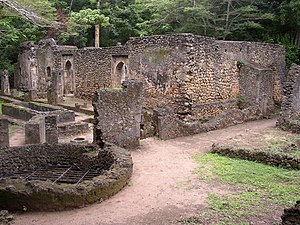| This article currently links to a large number of disambiguation pages (or back to itself). Please help direct these ambiguous links to articles dealing with the specific meaning intended. Read the FAQ. (January 2025) |
| Swahili city-states | |
|---|---|
| City States | |
 Map of East Africa City States Map of East Africa City States | |
| Formed | 8th century |
| Government | |
| • Head | Sultan |
| Government type | Autonomous City States |
| Language | Swahili |
| Location | East Africa Coast |
| Cities | |
| Religion | Islam |
| Ethnicity | Swahili, Shirazi |
The Swahili city-states were independent, self-governing urban centres that were located on the Swahili coast of East Africa between the 8th and 16th centuries. These were primarily coastal hubs, including Kilwa, Mombasa and Zanzibar, which prospered due to their advantageous locations along Indian Ocean trade networks, enabling interactions between Africa, the Middle East and Asia. They stretched from Mogadishu to Sofala.
Rise
Around the 8th century, the Swahili people established trade networks with Arab, Persian, Indian, Chinese, and Southeast Asian merchants, engaging in what became known as the Indian Ocean trade. These extensive trade routes introduced the Swahili to diverse cultural influences from Arabic, Persian, Indian, and Chinese traditions. By the 10th century, numerous including Kilwa, Malindi, Gedi, Pate, Comoros, and Zanzibar, thrived along the Swahili Coast and nearby islands. These city-states were predominantly Muslim, culturally diverse, and politically autonomous.
Their prosperity stemmed from the Swahili people's role as intermediaries, facilitating trade between local merchants and traders from Arabia, Persia, Indonesia, Malaysia, India and China. They competed for access to the lucrative trade of the Great Lakes region, exporting goods such as salt, ebony, gold, ivory, sandalwood and slaves. However, these city-states began to decline in the 16th century, primarily due to the arrival of the Portuguese. This marked the downfall of Swahili trading hubs and the eventual collapse of African-Asian commerce across the Indian Ocean.
Decline
The rise of Portuguese and Dutch dominance in Indian Ocean trade after 1500 significantly weakened the coastal city-states. Prominent centers like Sofala and Kilwa were transformed into European colonial outposts. The lack of a unified political structure left these city-states unprepared to counter the superior military technology and strategies of the Portuguese and Dutch.
Omani conquest of East Africa Coast.
Trade
The growth of Indian Ocean trade between Asia and Africa led to the development of influential coastal city-states in East Africa. Trade involved both local and international exchanges. These city states traded with kingdoms like Great Zimbabwe to obtain valuable resources such as gold, ivory and iron, which were the main exports of the region. They imported goods from Asia, including silk, cotton and porcelain.
| Trade Type | Goods | Description |
|---|---|---|
| Exports | Gold, Ivory, Salt, Ebony, Sandalwood, Slaves | These were highly valued resources sent to markets across the Indian Ocean. |
| Imports | Porcelain, Silk, Spices, Textiles, Beads | Luxurious items brought by merchants from Arabia, India, Persia, China, and Southeast Asia. |
The main trade network was Indian Ocean trade.
Architecture
Main article: Swahili architecture-
 Ruins of Great Mosque of Gede in Kenya
Ruins of Great Mosque of Gede in Kenya
-
 Kilwa Kisiwani ruins in Tanzania
Kilwa Kisiwani ruins in Tanzania
-
 Great Mosque Kilwa Kisiwani, Kilwa Masoko Ward, Kilwa District, Lindi Region
Great Mosque Kilwa Kisiwani, Kilwa Masoko Ward, Kilwa District, Lindi Region
Ethnicity
The Swahili people were a distinct ethnic group that emerged from the blending of African Bantu, Arab, Persian, and Indian cultures. This unique identity was shaped by centuries of intermarriage and cultural exchange within the coastal city-states. They shared a common language (Swahili), Islamic faith, and a vibrant maritime culture, which defined their cosmopolitan way of life.
The Swahili identity was closely tied to the coastal environment, with livelihoods centered on trade, fishing, and seafaring. Their strategic location along the Indian Ocean facilitated connections with distant lands, fostering a rich cultural heritage and sophisticated urban settlements, such as Kilwa and Lamu.
Language
The Swahili language, or Kiswahili, was the primary medium of communication in the Swahili city-states, serving as a cornerstone for consolidating regional trade networks. It is a Bantu language that evolved through extensive interactions with Arabic, Persian, and later Portuguese traders, resulting in a distinctive linguistic and cultural identity. Swahili facilitated not only trade but also diplomacy and cultural exchange, uniting diverse communities along the East African coast.
The language reflects a deep linguistic interplay with Arabic and other Indian Ocean languages, particularly through its significant incorporation of loanwords. Terms related to trade, navigation, and governance demonstrate its adaptation of Arabic phonetics and cultural influence. Additionally, Persian and Portuguese loanwords underscore its evolution through successive waves of external contact.
Swahili was traditionally written in the Arabic script, a practice that codified maritime and trade terminologies while contributing to administrative practices in the city-states. This script dominated until the colonial period, when the Latin alphabet introduced shifts in literary expression. Early Arabic-script manuscripts provide key insights into Swahili's role in governance and cultural life.
In city-states such as Kilwa, Mombasa, and Zanzibar, Swahili emerged as a cultural unifier among diverse ethnicities, reflecting its linguistic richness and cosmopolitan nature. The spread of Swahili through transoceanic migration further emphasized its centrality to East African cultural identity. Its blending of African, Arab, and Asian traditions underscores its dynamic role in shaping the region's cultural and linguistic heritage.
See also
References
- "Formation of Swahili City states". 2024.
- "Swahili City states". 25 June 2020.
- "Rise of Africa City states". 2024.